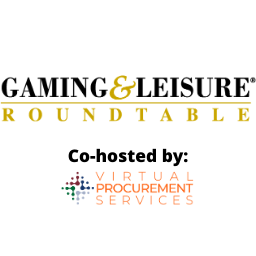Gaming & Leisure (G&L) successfully held its 19th annual G&L Roundtable, but this year in a “Live via Virtual” format. The G&L Roundtable is a coveted private forum attended by gaming and hospitality industry thought leaders.
With little time to pivot to a new plan, made even more complex by the forum’s fully-interactive style, G&L leaned on partner VPS to help plan, design, and execute the shift to virtual.
Check out the full news release here.
Optimus et Ultima
Podcast: Impact of COVID on the Gaming Industry
VPS Helps Convert Largest Private Gaming & Hospitality Event to Virtual
Webinar: Keys to Optimizing IT Spend
So you’re thinking about RPA?
Background
In its simplest form, Robotic Process Automation or RPA, is digitally automating repetitive and rules-based tasks: using bots to automate manual processes. In other words, using tools to emulate humans interacting with systems in order to complete business tasks in a more efficient manner.
It is a powerful tool for businesses that need to streamline operations and can be effective within any function of an organization in just about every vertical.
This isn’t “robotics” per se…that’s automating physical tasks. We are talking about digital automation through software robots.
Couple things to keep in mind up front:
-
Stock RPA is “dumb”. [stop giggling – not dumb in that sense – it’s actually awesome!] Dumb in the sense that it needs someone to teach it and keep it on track. However, you can add Artificial Intelligence (AI) and/or Machine Learning (ML) to create Intelligent Automation or IA. With IA, the RPA becomes smart and can learn the processes and associated tasks on their own to streamline and improve efficiencies even further. More on that in a future post.
-
For those companies that have done their homework and are ready to fully dive into this, there is hyperautomation. That is IA on steroids. It’s using an agile approach to rapidly deploy IA throughout as much of an organization as possible, smartly automating as many processes as possible, and gaining all the associated benefits. Not for the faint of heart and should only be done after you’ve had some early successes.
Use Cases
Anywhere there are repetitive tasks being done using software, there are candidates for RPA and these are just some of what are probably thousands of examples:
-
HR:
-
Team member onboarding
-
Attendance tracking
-
Benefits administration
-
-
Finance
-
Fraud detection
-
Month/year-end closes
-
Journal entries
-
Payroll processing
-
-
Gaming & hospitality
-
Flash/DOR reporting
-
Loyalty tier upgrades
-
Hotel room yielding
-
Guest service interactions
-
Fraud detection/AML
-
Marketing analysis
-
-
Healthcare
-
Account settlement
-
Claims processing
-
Patient care cycle
-
Compliance monitoring
-
Coding
-
-
Everywhere: Report creation, distribution, and analysis
If you’re familiar with any of these processes, you will immediately recognize how cumbersome and labor intensive they could be. Well, RPA can minimize most of the associated manual tasks within and, in some cases, even automate them 100%! [C’mon…I know your mind is racing now thinking about all the great things RPA can do in your world!]
Benefits
The benefits are immense as you could imagine:
-
Improved efficiency
-
Reduced errors
-
Reduced risk and greater compliance
-
Increased transactional throughput with the same FTEs
-
Reduced completion times
-
Granular data analytics
-
Seamless scalability
-
And so many more
Plus bots don’t get sick, they don’t call out, they work 24×7, and they will never go outside whatever lines you establish.
Think about all the downstream benefits to customers, team members, and ultimately your bottom line, as well as the sub-benefits for each. Think about things like being able to reassign your teams to more strategic work, scaling up and down as demand shifts without workforce changes, improved guest service with consistent 24×7 interactions, and access to real-time data to be able to measure every step. Pretty awesome.
Tips & guidance
So – truly an amazing technology that you should dive right into, huh? Not so fast! To be successful with RPA, there are some key things to keep in mind:
-
Implement organizational change management
You will be implementing solutions that will completely change the way business users work and, even if it’s for the better, it’s still change. Especially if your organization suffers from a “we’ve always done it like that” mindset which will be detrimental to RPA’s success. Consider their perspective, which may include fear for their jobs and a fear of the unknown, and adapt your approach accordingly with good organizational change management.
The way to offset these concerns and those mindsets is to communicate clearly and communicate often to create a culture of change acceptance. Let team members know why you are doing this and get them involved in the planning. In addition, it’s important to ensure you have buy-in at a senior level so those leaders can help to plant the RPA seeds and reassure folks that the efforts are in everyone’s best interest and will hopefully result in those same team members working on more strategic and higher-value tasks.
-
Attain a deep understanding of the targeted processes & tasks
Collaborate heavily with all of the users involved in the processes that you are looking to automate through processes analyses and process mining. Ask the hard questions to get to root answers so you can properly incorporate into your planning and ultimately the RPA solution. Utilize tools to help mine processes – tools that will be able to sift through application, database, and system logs to truly determine end-to-end processes.
Also, and this tip seems counter intuitive, but you want to be careful about automating completely inefficient processes. Obviously, those should be corrected or eliminated beforehand so that you are not simply automating broken processes. The age-old adage of “Garbage In/Garbage Out” could not be more apropos in this situation.
-
Keep IT Involved
This is a heavily argued point with RPA, but I believe firmly that IT must be involved from start to finish. Even if you think it’s an independent process change, get IT involved as there will be a ripple effect to utilized apps and technology including required integration and data points. There are also security and compliance aspects involved that business units may not be aware of.
RPA is technology and something that IT will either directly or indirectly support post-implementation, so keep that in mind and keep IT engaged. This is not a time for shadow IT and, if you choose that route, you will pay the price down the road.
-
Measure twice to cut once
As with any IT effort, you’ll want to spend a lot of time upfront on analysis and planning. Consider who is going to run the effort, who it will impact, how you will fund it, and then plan accordingly. In addition, think about whether this is going to be something that you purchase and support in-house or if this is an opportunity to outsource as a service for potentially more savings. Both options exist – it really comes down to your internal capabilities and appetite.
Ultimately, if you can tie it to an overall digital transformation effort and your technology roadmap, the more effective this planning will be. As part of that planning, establish baseline metrics and then efficiency goals as KPIs, then implement measures to track that performance and tweak as needed. You will derive those from the current process tasks and the expected target levels through automation.
Lastly, keep cyber security and compliance paramount. You will be introducing new technologies that could pose security risks if not handled properly and touching processes that may be governed by compliance standards.
-
Ensure that you have a good foundation
While sometimes unavoidable, try not to automate on legacy technology or broken tools. RPA is not a band-aid so fix your foundational items first. This includes not only the directly impacted applications and processes, but those downstream or integrated. Think about things like your underlying enterprise architecture, networking, storage, compute technologies, etc. If you must, make temporary RPA changes to capitalize on the benefits, but immediately build a plan to dovetail into future foundational upgrades.
-
Procurement is still the ‘Wild West’
This is a $5B industry and is expected to more than double by 2023. The landscape is chock full of startups, consultants, and established vendors eager to get into the game and capitalize on the opportunity, with a myriad of products, solutions, and offerings.
At the same time, it’s still a relatively unknown practice in regards to how to deploy and maintain, so it becomes a target for purposeful overarchitecture. Be wary of that with these tips:
-
-
Licensing is overly complicated; think “cloud provider-type of licensing fun” times 10. Cases of customers being oversold are rampant. They have no means to validate and no way to adjust after signing the contract. Become familiar with the licensing models and only buy what you really need.
-
Service costs are typically triple that of your software investment. Think about that…for every dollar spent, you are spending at least $3 on services! Partners will try to squeeze every dollar out of the contract with perpetual upkeep instead of teaching you how to fish. Figure out exactly what you need in your planning, then set up your contract accordingly.
-








